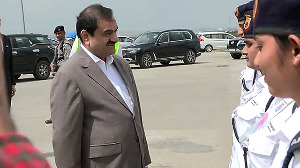An Indian technologist in Australia has challenged Newton's First Law of Motion and called for a revision of the classical theory in the light of modern technology.
According to Newton's First Law of Motion an object at rest tends to stay at rest and an object in motion tends to stay in motion, unless acted upon by an external force.
Arindam Banerjee, an alumnus of the Indian Institute of Technology-Kharagpur, argued in his recent book, To The Stars!, that contrary to Newton's theory an object can actually be moved without application of any external force.
"Central to my theory is the proposal that our understanding of Newton's First Law of Motion should be revised," the 47-year-old research technologist, who works for Telstra in Melbourne, told PTI.
Based on his unconventional theory, Banerjee has described in a technical paper, a design for a 'perpetual motion machine,' which can generate energy without burning any kind of fossil fuel or using any radioactive process.
Called the Internal Force Engine, Banerjee claims it would never run out of power because it is 'self charging' without the need for any external source of energy.
"It is a machine driven by energy internal to the body and can achieve unlimited kinetic energy within a short span of time, using much less energy obtained from external sources like a battery," he said.
The balance energy generated thus is free and could be produced indefinitely if a feedback loop is created in the system, Banerjee contended.
The technologist has created an electro-magnetically propelled Internal Force Moved Body, which demonstrates that objects can be made to move from rest without friction, without expelling mass at high speed (as in rockets) or without any externally applied force, thus violating Newton's First Law of Motion.
Through a series of complex cycles involving a hydraulic system that channelises oppositely directed kinetic energies, Banerjee's IFMB produces ever increasing velocity with each cycle with 'no upper limit' to the velocity that it can reach.
Though his theory is based on the assumption that our present understanding of the Law of Conservation of Energy (which says: Energy can neither be created nor destroyed) is flawed, Banerjee clarified that certain new concepts arising out of his own postulations would have to get a firm footing first.
"For instance, the concept of 'internal force,' 'internal force moved body' and 'velocity addition' as proposed in the new theory would need innovations in the fields of electromagnetic and hydraulic systems," he said.
Successful implementation of the concept, fortified with designs and mathematical derivations, could mean a gradual elimination of the conventional sources of energy (fossil fuels) ensuring a pollution-free environment, the technology expert said.
The theory could also be used to describe the principles for the design of interstellar spacecrafts using the perpetual motion machine, Banerjee pointed out.
"Designing an engine that delivers more power than it takes to run has been a dream for all engineers. This concept has the potential to create a portable, cheap and no-noise machine to propel even huge systems," he said.




